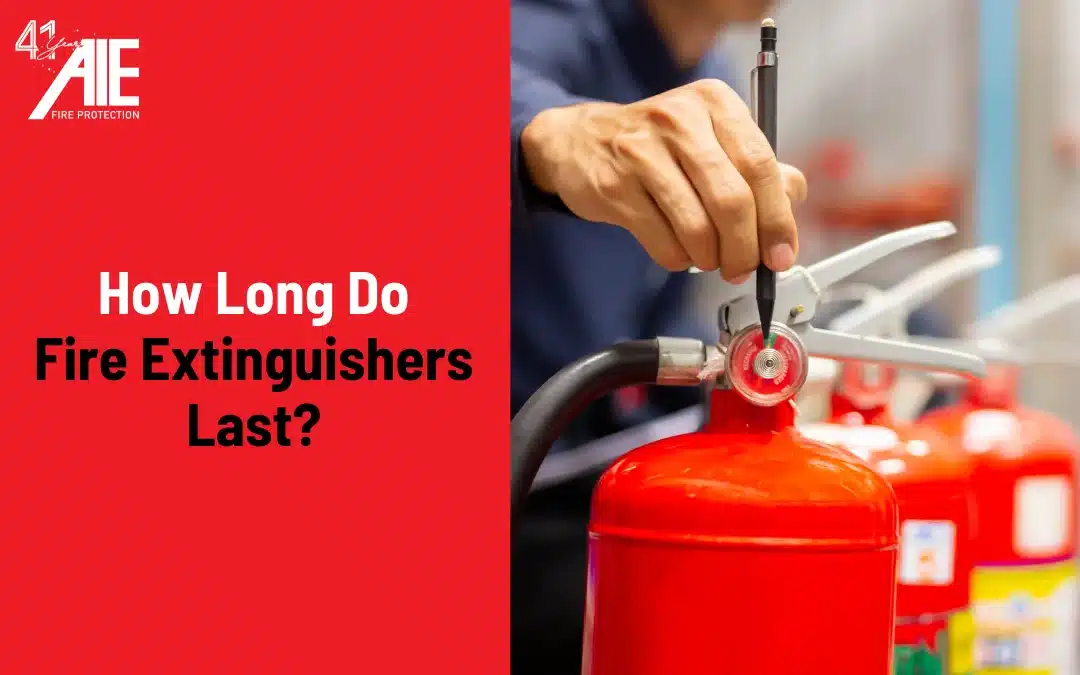Every commercial or industrial building is required to have fire extinguishers because of the codes instituted by the National Fire Protection Association (NFPA). The exact number of fire extinguishers is dictated by the size, type, square footage, and operation of the building but the most critical component of each extinguisher is that it’s functioning.
That means making sure the extinguishers have not gone bad or expired — and many people don’t realize that fire extinguishers do not last forever. Once a fire extinguisher is past its expected lifespan, it is no longer considered fully functional, and it may not work in the case of an emergency.
Here’s what you need to know about how long fire extinguishers last, how to measure expiration, and whether maintenance can help extend their lifespan.
How long do fire extinguishers last?
While most fire extinguishers do not have a set expiration date, the general rule is that a fire extinguisher will last ten to twelve years. At that point, a fire extinguisher should be inspected and/or replaced to make sure that you have a fully functioning extinguisher in place.
The exception is rechargeable fire extinguishers, which should be recharged every six years.
How should I inspect a fire extinguisher?
The time to find out your fire extinguisher is not working is not in the moment when you need to use it. Fire extinguishers should be inspected regularly to make sure they’re in good working order, ready to spring into action if there is an emergency.
To make sure your fire extinguishers are in tip top shape, the NFPA recommends inspecting them when they are installed and once a month after that. This is especially critical in commercial and industrial settings.
According to the NFPA, this should include making sure that it is in its correct place and that signage, visibility, and accessibility are clear. Then, make sure that the pressure gauge is in the operable range or position. Confirm that the extinguisher is full, and check that all parts are in working condition. There should be a push-to-test pressure indicator on a non-rechargeable extinguisher, which will indicate when the fire extinguisher has expired.
If the fire extinguisher fails any of these inspections, then it is no longer cleared for use and should be replaced immediately by a certified professional.
Do fire extinguishers need regular maintenance?
Regular maintenance and inspections can help extend the life of a fire extinguisher. If there was ever a time to keep all of the paperwork and guides from purchasing an item, this is it. Your manufacturer’s service manual will have the exact instructions for maintenance of your extinguishers but, generally, according to the NFPA, this will include making sure the mechanical parts, extinguishing agent, expelling agent, and physical condition are all in working order and that repairs are made and replacements are done as needed.
This annual maintenance needs to be done by a person who is certified in fire extinguisher maintenance, and it is necessary to keep the fire extinguisher functioning well (and help it last longer!). And, don’t forget to keep a careful record of both purchase dates and maintenance so you know when it’s time for another inspection — or another extinguisher.
How to dispose of a fire extinguisher
If your fire extinguisher has reached the end of its lifespan, don’t throw it away the way you would a normal household item. Fire extinguishers should be taken to a local hazardous waste disposal facility because they can dispose of the toxic materials properly.
Never get caught with an expired fire extinguisher
Keep your fire extinguishers in working order, and depend on AIE Fire for the best fire protection solutions possible. Contact us today to learn more about our services and how we can help you outfit your commercial or industrial space with fire extinguishers that will keep you, your colleagues and your customers safe.


Recent Comments